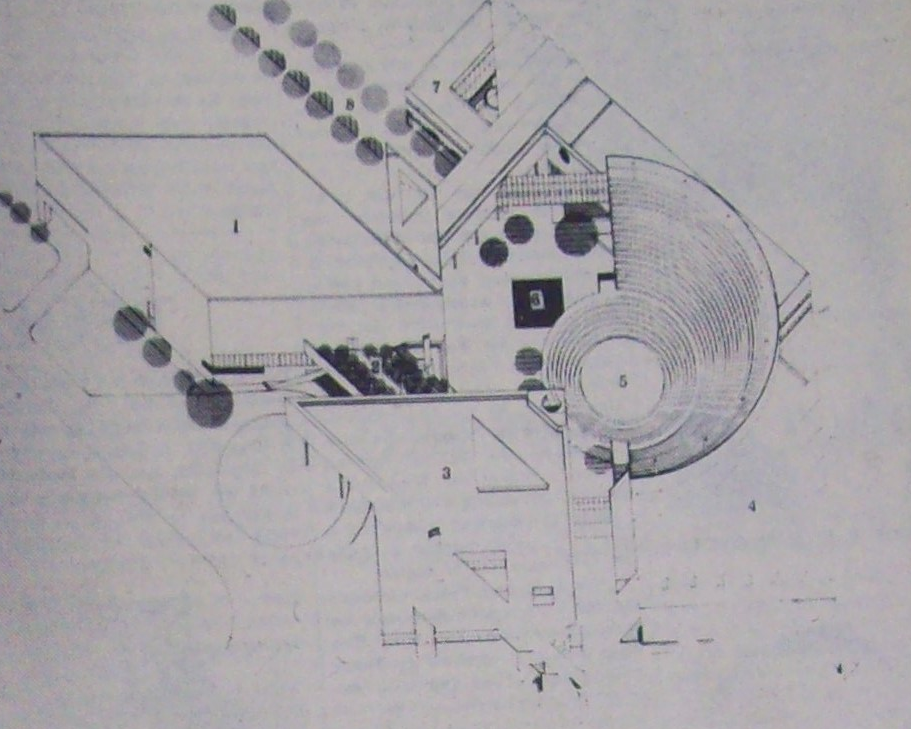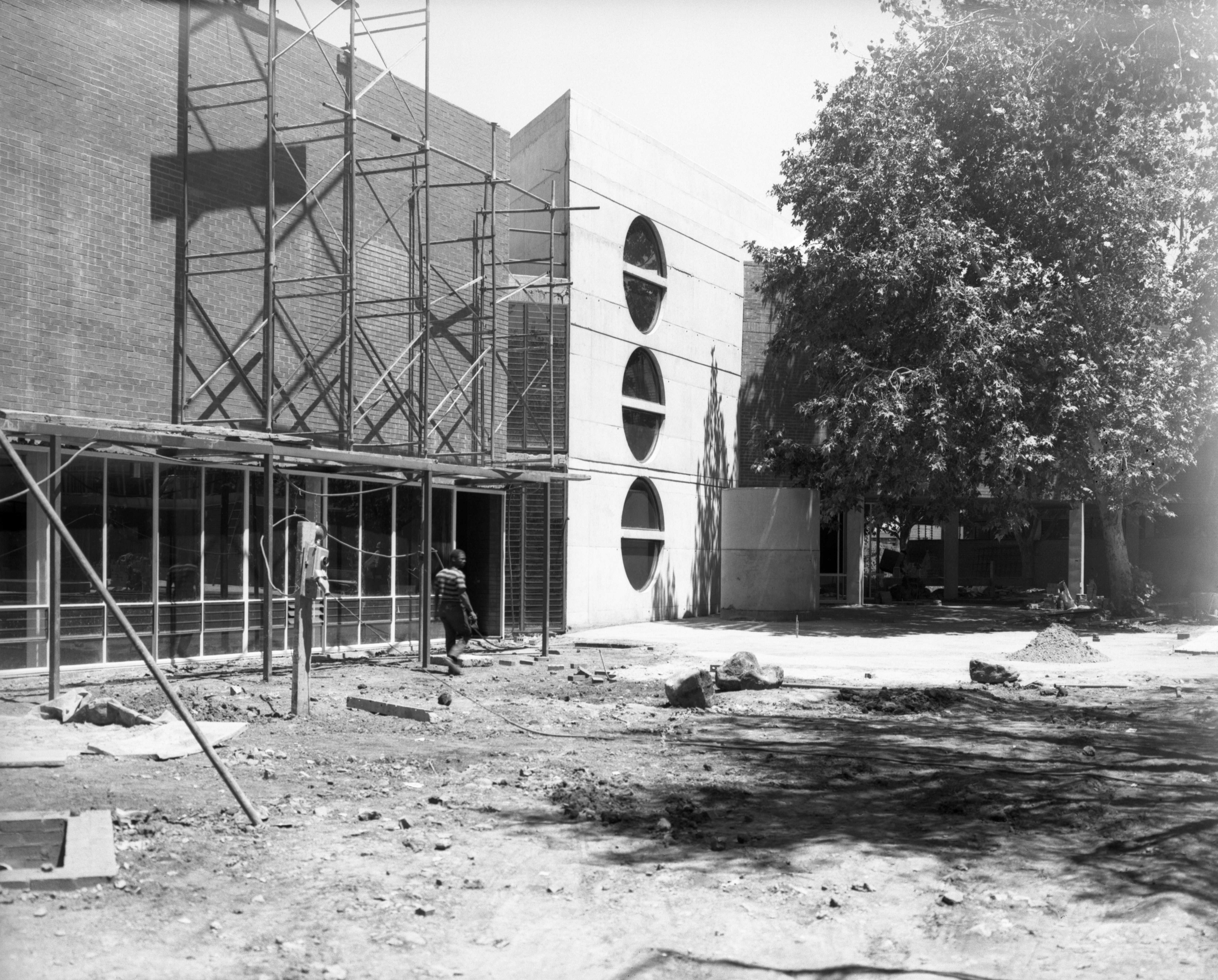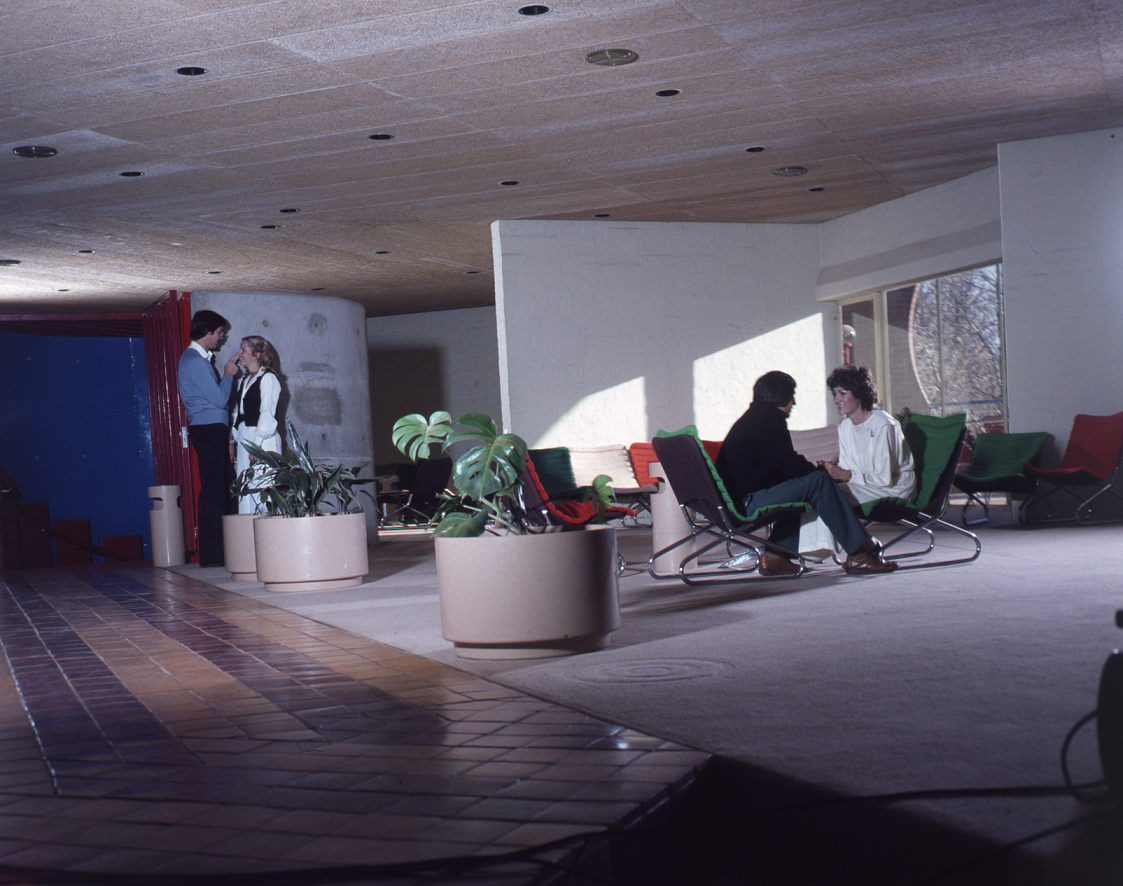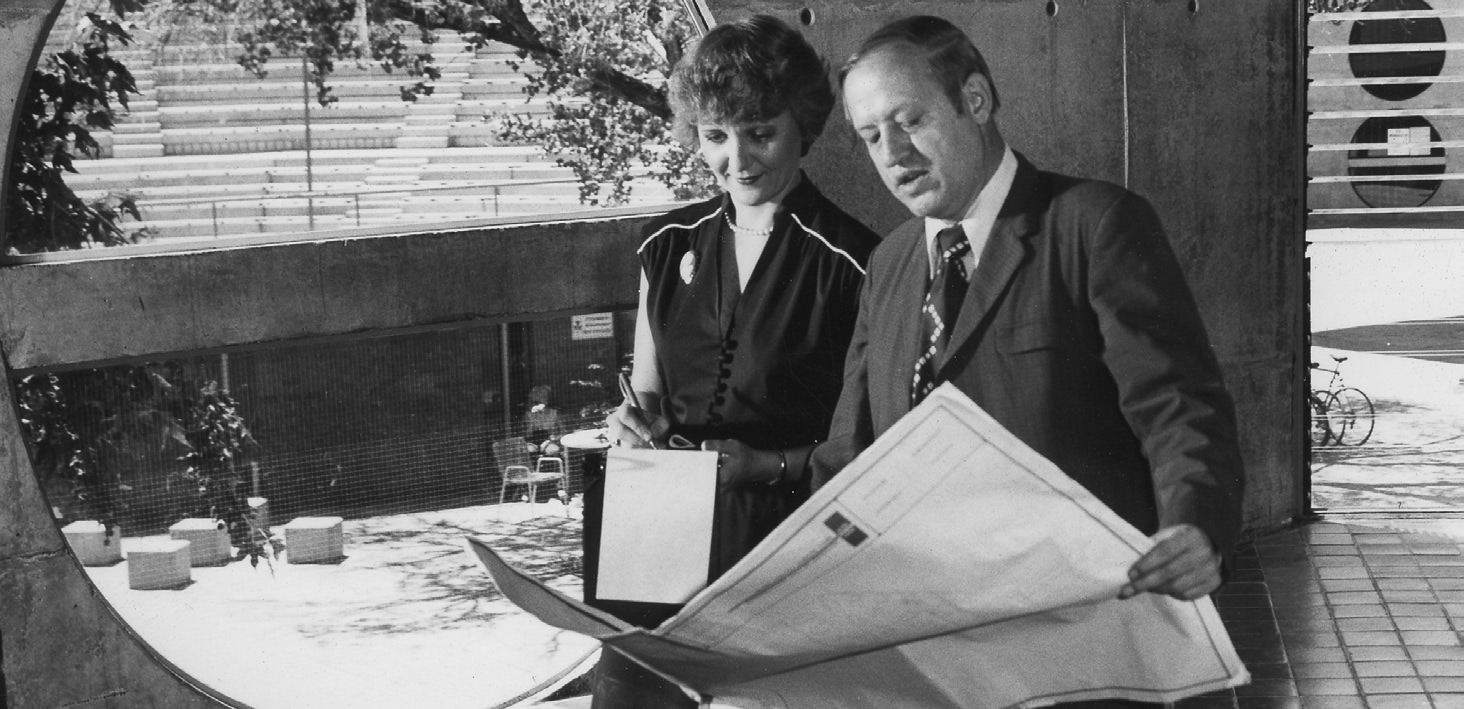Student Centre ("SS")
Student Centre today (Klipoog Cafeteria)
- The first place where students could congregate on the current campus, after it had relocated here in 1923, was a galvanised iron hall. It was one of eight structures that the Potchefstroom University College acquired from the military authorities. Most were furbished for academic purposes and one was a hostel for men, “Ons Huis” (Our House) that stood where the Main Building is now.
- Where the Totius Hall is today, between the Main Building and Heimat Residence, stood a galvanised iron structure that was initially used as a laboratory. By 1950 it was the offices of the Students’ Representative Council, its archive, store room and student hall which could hold 200 standing. It was, however, already far too small, since in 1949 the PUC already had more than 700 students.
- The second student hall was the Totius Hall that was built in 1953. By 1970 it was also too small. Plans were already being made for a new Student Centre and building work started in 1974.
- The Rector, Prof Hennie Bingle, had the vision and dream that it would be the heart of student life and a focal point on the campus.

Photo: Prof Hennie Bingle
- The architects, WO Meyer and B Britz, were commissioned to design the comprehensive plans. GA du Toit and partners were appointed as the mechanical and electronic engineers.
-
The Centre was placed in the middle of the campus and from there footpaths radiated in all directions to the whole campus. Main components are the auditorium, the sports centre, offices for the Students’ Representative Council and cafeteria.
-
By 1972 the planned building costs doubled. Eventually it would cost R5 million.

Photo: Student Centre plan
This architect’s drawing of the Student Centre was published in the PU-Kaner on 9 August 1974.
It shows (1) the hall (auditorium) (2) roof garden (which was later changed) (3) cafeteria and lounges (4) indoor sports venue and sports rooms (5) amphitheatre (6) courtyard and fountain (the latter does not exist anymore)
(7) offices of the Students’ Representative Council and (8) one of the walkways (today known as Lovers Lane)
- Bannie Britz, one of the collaborating architects of the Student Centre, wrote this description of architectural objectives and style of the Student Centre. It was included in the programme of the inauguration of the Hennie Bingle Student Centre in 1980.
Ten years ago planning the Student Centre commenced. It was at a time of worldwide student unrest. The then rector, Professor Bingle, gave the instructions that the complex must be built in such a manner so that students feel at home on the campus. He wanted a building with a specific simplicity and robustness to give expression of specific characteristics of the Afrikaner. The complex should consist of an auditorium, committee rooms, offices, a council chamber for students and the Students’ Representative Council, a large comprehensive indoor sport centre, cafeteria with lounges and a large open-air amphitheatre.
- The building had to be an educational instrument. Currently comprehensive urbanisation is taking place. City dwellers use their time differently than rural people. The building had to stimulate towards creative and active use of time, by making people aware of the wide range of activities that the city in our time provides.
- It should be a building where young people would feel at home. Use of colour should be an important means to stimulate youthful joie de vivre.
- A first local prototype of a type of complex which – especially in Europe became increasingly popular – was planned. The function of a general gathering place, which for example was fulfilled by the Greek Agora or the medieval town square, is missing in the modern city. Modern means of travel and communication are tearing the city, and with that the community, apart. Multi-purpose community centres, that are built more and more, serve as focal points in many cities. A point of equilibrium in the university, was sought, which at the same time draw people from inside and outside, like a magnet, to thus effect interaction.
- The internal ring street, which Britz described, meant that a route existed on the level of the first storey. This meant that one could walk from the cafeteria, through the sport centre and SRC offices to the foyer of the Auditorium and from there again to the cafeteria. This circle route later had to be blocked off for security purposes. The Student Centre also lost the fountain in the courtyard.

Photo: Student Centre under construction
Wapad published this photo of the Student Centre under construction. In front is the cafeteria and lounges block and in the upper right a part of the Amphitheatre can be identified.

Photo: Student Centre under construction - 1978
- The Student Centre was named after Prof HJJ (Hennie) Bingle, 1910-2007, Rector from 1964 to 1977 and Chancellor from 1981 to 1991. He is described as a managerial expert that “with imaginative planning, thorough control, responsible financial management and healthy co-ordination made the PU a fundamentally sound operation that grew in size and importance.” This is according to Chancellor Jan de Klerk in 1977 who spoke during a function when Bingle retired. During Bingle’s term he applied himself to the development of the terrain and building projects, which had the effect that student numbers tripled in the 13 years of his term as rector. During a function to pay homage to what would have een his hundredth birthday, another former Rector, Prof Carools Reinecke, described him: “Everybody knew what they had to do and nobody took the risk to end up in his bad books. Those ice blue eyes of his, with reason, gave him the nickname “Klipoog” (rock eye).” The Klipoog cafeteria in the Student Centre is therefore named after him. Bingle was aware of this and welcomed it.
- The Student Centre (which quickly acquired the nickname “SS” under the students – short for “Studentesentrum” the Afrikaans name) opened its doors on 24 July 1979. For the students of 1979 it was a wonder world. At the old cafeteria, next to the Totius Hall, one could mainly by pastries, sweets, tee, coffee and cold drinks. The new cafeteria had a myriad of treats, takeaways and cooked meals available.
- Directly north of the initial cafeteria, the first Drakenstein Restaurant opened its doors. This meant that the Potchefstroom University for Christian Higher Education, for the first time in its 110 year existence, had to apply for a liquor licence. This licence could only be issued to a person, not an institution and meant that it had to be in the name of the Rector, Prof Tjaart van der Walt, a former reverend!
- The spacious eating area and the large lounges had a wonderful appeal. “We just went there, just to sit and enjoy it,” recalled a student from that time. These lounges were so popular that the furniture soon became damaged. Apart from the normal wear and tear, the chairs were also carried away. By 1988 it was considered to remove the chairs altogether. In 1989 the lounges were turned in the Alumni Hall.

Photo:
The large and small lounges were delightful gathering spaces in the new Student Centre. (Besembos 1980)
- Initially it was estimated that the Student Centre would be ready to use during the second semester of 1978. Plans to make this happen were already made in 1977. The Centre was only ready in the second semester of 1979
- The task to bring the Student Centre into operation was placed on the shoulders of Mr Hans van Zyl. He was appointed as director of the Student Centre in 1978 and this legendary cheerleader from the early sixties had to see to it that the cafeteria, the indoor sport complex and the Auditorium had to operate without glitches.

Photo:
Hans van Zyl was appointed as the director of the Student Centre in 1989.
With him is Mrs H du Plessis, secretary of the Student Centre.
- One of his tasks was to see to it that the Centre was properly locked at night. In the Centre were 38 outside doors, numerous air-conditioners and cooling apparatus, a myriad of light switches and two television sets. At closing time everything had to be locked, switched-off and checked. This took from half an hour to three quarters of an hour and in the same time he had to check that nobody was in the building.
- In 2000 the Student Centre was extensively refurbished, after it had started operating more than 20 years before, to create the appearance that would be recognisable to the students of today.
- The construction of the first phase started in June and was completed in January 2001. The new part of the Centre now comprised of three levels: a ground level, mezzanine and top level. The three levels provided seating for about 500 student
- The existing self-service area was enlarged more than three times with five pay points. The second phase included the upgrade of the Alumni Hall. That started in 2001. The design was done by architect Gerrit Jordaan of Holm Jordaan & Partners of Pretoria.

Photo: Besembos 1980
With the Rector of the PU for CHE, Prof Tjaart van der Walt (left) on this photo, that was taken during the inauguration of the Student Centre,
are Prof Hennie Bingle, former Rector, after whom the Centre was named, Mr Wilhelm Meyer,
university architect, Mr Bannie Britz, architect who designed the Centre and Mr Hans van Zyl, first director of the Centre.


